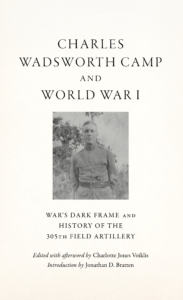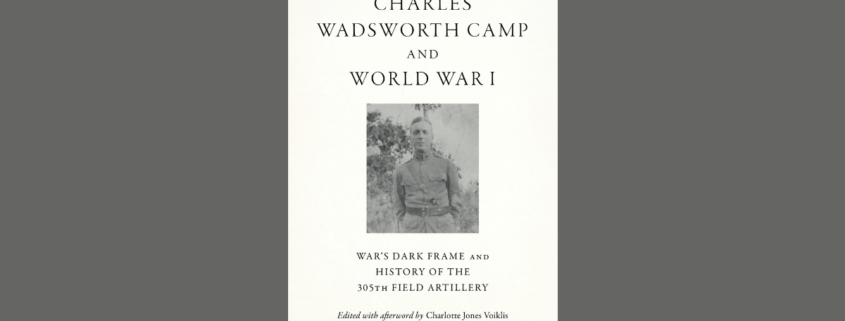Charles Wadsworth Camp (Madeleine’s father) and World War I
Dear Ones,
Today is Madeleine and Hugh’s wedding anniversary (they were married in 1946), and it is also the pub date of a new book: Charles Wadsworth Camp and World War I: War’s Dark Frame and History of the 305th Field Artillery.
 Charles was a journalist, critic, novelist, and playwright, and this new volume is a compilation of his two books on the war, one written as a journalist covering the conflict before the US entered it, and one written as a soldier. It features and introduction by historian and National Guard officer Jonathan D. Bratten and an afterword by Charlotte Jones Voiklis. Bratten’s introduction puts Charles’ journalism and history in context, and describes the formation of the National Army. Charlotte’s afterword is a personal reflection on family history and Charles’ influence on his daughter Madeleine.
Charles was a journalist, critic, novelist, and playwright, and this new volume is a compilation of his two books on the war, one written as a journalist covering the conflict before the US entered it, and one written as a soldier. It features and introduction by historian and National Guard officer Jonathan D. Bratten and an afterword by Charlotte Jones Voiklis. Bratten’s introduction puts Charles’ journalism and history in context, and describes the formation of the National Army. Charlotte’s afterword is a personal reflection on family history and Charles’ influence on his daughter Madeleine.
This is a first effort at self-publishing, and we hope you like it! The ebook is available now from wherever you get your ebooks: Amazon has special pricing until the release of the print edition which will be April 29 (the day Charles’ battalion arrived back in New York Harbor).
From the introduction:
Camp visits Paris, Lorraine, the Marne, Champagne, Flanders, Arras—in short, all the places that the French and British would have liked an American journalist to see in order to inflame US sensibilities concerning the war. He visits coal miners building tunnels under No Man’s Land into the German lines and describes a heart-pounding narrative of life in the British sector, where he dodges artillery shells and then has tea with British officers. His small snapshots of the war are vivid and filled with color. In the end, he keeps bringing his readers back to the same problem: what is the United States doing about all of this?
From the afterword:
My grandmother was a storyteller, and not just in written word but also in conversation. It is how she liked to engage in dialogue with people, offering narratives that invited the listener to imagine they were part of the same story. When I was a child, she told me stories while cooking, gardening, riding the bus, and during quieter moments sitting in her lap or, when I was older, drinking tea. She told stories about her parents and grandparents, as well as more distant relatives, particularly those who settled in north Florida when it still “belonged” to Spain. She left the South for college and only went back for short visits. She always considered herself a New Yorker and always felt that she had escaped the South. While her relationship to her southern roots was full of contradictions and ambivalence, she took pleasure in the stories she chose to tell (and that had been chosen for her, for there were many that had been passed down to her). She continued to tell those stories, not just to her grandchildren, but to her readers, too, keeping their memories alive but also fixed like a doll on a shelf that could be taken down and petted but not played with too roughly. I know there are other stories, too, that are not quite so pretty or proud, more like the shards of glass in the leather box—sharp and full of pain. Not all stories about her own parents and childhood were doll-like. Some of them were alive —shimmering, shifting, escaping her deft narrative skills—and created in me a curiosity and skepticism.



